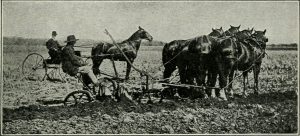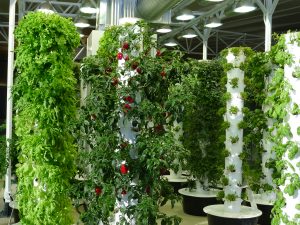3 Agricultural Technologies During The G.I. Generation
Dion Robinson
3.1 Technological Influence
Keywords
- Catastrophic events- catastrophic events are distinguished from environmental stochasticity in that they are relatively unpredictable and infrequent events that exceed the more extreme limits of normal year-to-year variation in environmental conditions
- Fertilizer- a chemical or natural substance added to soil or land to increase its fertility
- High yields-producing a large amount; giving a high return:
- Pasteurization- the partial sterilization of a product, such as milk or wine, to make it safe for consumption and improve its keeping quality
- Inventive- having the ability to create or design new things or to think originally
- Reforestation-the process of replanting an area with trees
- Droughts-a prolonged period of abnormally low rainfall, leading to a shortage of water
- Threshers- a person or machine that separates grain from the plants by beating
- Mass Production- the production of large quantities of a standardized article by an automated mechanical process
- Combustion Engine- is a heat engine in the sense that it transfers the energy released by the heat generated by the combustion of gasoline into mechanical work, or torque. Torque is given to the wheels in order for the automobile to move forward.
Learning Objectives
- By the end of this chapter, students should be able to:
- Identify the three main causes of the Dust Bowl
- What agricultural technologies were developed during the early 1900s?
- The “Great Migration” and the societal effects on agriculture in the Midwest.
The developed technologies in the agriculture industry during the early 1900s in the United States lead to a nationwide disaster. The silent generation had plenty of technological breakthroughs, although responsibility with that technology wasn’t considered. The great plain used this technology to create a phenomenon we’d never seen before, scattering dust across the country. All due to poor technological, economical, and legislative planning. It would soon be called the Dust Bowl. This was a result of not knowing what the technologies we were implementing would do to the land that they were being exercised on. Ultimately leading to a great migration of a sizable population, from the Midwest to the west towards states like Oregon, California, and Washington.
Detailed letters of individuals that had first-hand experiences in the catastrophic events, and what technologies/methods lead to that unfortunate set of events. The desire for certain crops and mass production was at an all-time high in our society’s history. This failure led to better laws helping the environment and the land that was being cultivated. To prevent another event like this to occur and lead to improvements in overall agriculture nationwide.

“Agricultural engineering; a text book for students of secondary schools of agriculture, colleges offering a general course in the subject and the general reader” by Davidson, Jay Brownlee, 1880-1957 is in the Public Domain, CC0
3.2 Technological Developments
Key Takeaway(s)
There were plenty of technologies being developed during this era in time. For example, the mass distribution of fertilizer (natural substance that helps the fertility for plants), combustion engine (gas burning) for tractors, and the increased production from the diversification of crops. With the newly developed technology the annual consumption of commercial fertilizer was increased from 1.8 million tons to 6.8 million tons between the 1900’s and the 1920’s (Bellis, 2021). Ultimately showing the increased yield in crops and farming cycles.
3.2.1 Mechanization
The use of mechanized power was really effective once the gas burning tractor was created. It was the first-time agriculture didn’t rely on an animal for production. The Tuskegee Institute’s agricultural research department found new ways to use crops like peanuts, sweet potatoes, and soybeans. The rubber-tired tractor was developed to help comfortability among farmers, aiding in performance resulting in longer workdays.
3.2.2 Improvements
Organic farming was being implemented into farming. It was discovered in the 1910’s and slowly beginning to gain traction. It was used too late to stop the dust bowl, but their methods included crop rotation, biologically based pest controls, and animal manures. The demand for organic produce and meats didn’t happen until the 1960’s though.
3.3 History of Agriculture
Key Takeaways
Looking at the technology that was used in farming in generations before the G.I. generation. Farming methods also changed after the mechanization of farming.
3.3.1 Effective Farming methods

3.4 Social Impacts
Key Takeaways
Technology was in a golden era; the industrial revolution was on the downward trend, but it didn’t stop inventive minds. Society at the beginning of the 20th century was flourishing.
Up until the dust bowl and the great depression. Agriculture was no exception between 1900’s- 20’s production for the country’s food supply was at an all-time high and vastly increasing. Demand for these crops was high and continued to stay high for a while until suddenly the supply greatly overcompensated the demand.
3.4.1 Intended Consequences
Mechanizing farms and making the workhours for crops made farming much easier than before. Giving farmers an easier time tending they’re farms. In turn, crops were yielded at incredibly high rates. It helps to keep the economy flourishing. In turn more investments and inventive minds went towards agriculture in the United States.
3.4.2 Unintended Consequences
The environment during the era of mass farming caused what we know now as the Dust Bowl. Years and years of tearing up the ground and packing it back down and draining the nutrients out caused dust. While high yields and “rapid farming” was ideal it wasn’t the best course of action to keep the Midwest’s’ dry climate from negatively affecting soil, droughts, and clouds. Farming unintendedly caused the great depression with farming pulling out loans for new equipment, and not being able to pay back debts due to crops not yielding results. As a result, farmers were not economically holding their end of the economy up and creating a domino effect.
3.5 Evolution of Agriculture
Key Takeaways
Today’s changes and improvements on agriculture due to the consequences of early 1900s farming.
Soon after the dust bowl the government realized it needed to put rules and regulations in place to keep something like this from happening again. Creating the Civilian Conservation Corps which was created to reforestation and come up with more efficient and less damaging farming methods. An easy method of rotating between the sections of land was very affecting moving forward. Which was also created to help with the economic crippling of the great depression of that time and help other societal issues at that time.
3.5.1 Changes of Today
Farming has changed to suit less acres and more produce. Things like indoor vertical farming has increased crop yields while decreasing the land that is being used and decreasing the impact on the environment. Blockchain is also a technology that was implemented to help trace back where produce is coming from. Showing if someone is yielding to much and could be hurting the environment if their trends continue. Irrigation has improved a drastic amount which helps with the soil and prevents things like over dried soil, and crop yields. Leading to less unsuccessful harvest, and more successful harvest which makes the soil they use more valuable than constantly planting, harvesting and plowing.

“Chicago O’Hare Airport Vertical Farm” by Alvin Kho is licensed under CC BY-NC-SA 2.0
In The Depths of The Dust
Mrs. Caroline A. Henderson diary brings to light the events of the Dust Bowl, Great Depression, and the Great Migration during her generational timeline:
“It is an almost hopeless task, for there is rarely a day when at some time the dust clouds do not roll over. ‘Visibility’ approaches zero and everything is covered again with a silt-like deposit which may vary in depth from a film to actual ripples on the kitchen floor. I keep oiled cloths on the window sills and between the upper and lower sashes. They help just a little to retard or collect the dust. Some seal the windows with the gummed-paper strips used in wrapping parcels, but no method is fully effective. We buy what appears to be red cedar sawdust with oil added to use in sweeping our floors, and do our best to avoid inhaling the irritating dust.
In telling you of these conditions I realize that I expose myself to charges of disloyalty to this western region. A good Kansas friend suggests that we should imitate the Californian attitude toward earthquakes and keep to ourselves what we know about dust storms. “
Now consider this: These conditions were all new to the farmers, who had personally never experienced such a devastating environmental event. To have to put Vaseline in your nostrils to keep from inhaling too much dust is rather extreme in our context but for them it was a matter of trying to survive the dust storm. Do you think you could’ve survived a dust storm in the 1930’s?
Chapter Summary
The technological changes that happened during the G.I. generation accidentally caused the dust bowl. Efficiency that was used to produce crops at record pass also caused the destruction of the soil in the Midwest. Since then, we’ve learned methods and technologies that have helped to never recreate an event like the Dust Bowl again. Organic farming and organic produce have gained popularity over the years and now you can go into any grocery story and find organic produce. Agriculture is always evolving and changing to suit the economy, society, and environment. It should continue to change and become more effective throughout the years.
Review Questions
- How much did the annual consumption of commercial fertilizer in the 1900’s?
- 1.8 million tons
- 900,000 tons
- 1.2 million tons
- 1.3 million tons
- What replaced horse-powered plows in the early 20th century?
- Cotton-stripper
- Gas Tractors
- Mule-power
- Sharecroppers
- What percentage of the labor-force were farmers in the 1920’s?
- 28%
- 10%
- 19%
- 40%
Answers:
-
- 1
- 2
- 4
Food For Thought
- What do you think farmers in the early 1900’s could’ve done differently to prevent the dust bowl?
- How did the pass of the Homestead Act of 1862 affect the environment?
- Do you think with laws and technology being used today that we could see a second Dust Bowl in the future?
References
Henderson, C. A. (2020, May 20). Letters from the Dust Bowl. The Atlantic. Retrieved November 8, 2022, from https://www.theatlantic.com/magazine/archive/1936/05/letters-from-the-dust-bowl/308897/
Bellis, M. (2021, February 6). American farm machinery and technology changes from 1776–1990. ThoughtCo. Retrieved November 8, 2022, from https://www.thoughtco.com/american-farm-tech-development-4083328
History.com Editors. (2009, October 27). Dust bowl. History.com. Retrieved November 9, 2022, from https://www.history.com/topics/great-depression/dust-bowl
Dust bowl migration – rural migration news: Migration dialogue. Dust Bowl Migration – Rural Migration News | Migration Dialogue. (n.d.). Retrieved November 9, 2022, from https://migration.ucdavis.edu/rmn/more.php?id=1355
Ganzel, B. (2003). The dust bowl. Wessels Living History Farm. Retrieved November 9, 2022, from https://livinghistoryfarm.org/farminginthe30s/water/the-dust-bowl/#:~:text=The Dust Bowl The most visible evidence of,carried in storm clouds for hundreds of miles.
Hillison, J. (n.d.). CITESEERX. CiteSeerX. Retrieved November 20, 2022, from https://citeseerx.ist.psu.edu/
Hall, R., Leavitt, P. r, Quinlan, R., Dixit, A., & Smol, J. (1999, May 15). Retrieved November 11, 2022, from https://aslopubs.onlinelibrary.wiley.com/doi/epdf/10.4319/lo.1999.44.3_part_2.0739.
Miller, J. (2017, July 8). 20 tragic photos from America’s Dust Bowl in the 1930s. History Collection. Retrieved November 20, 2022, from https://historycollection.com/20-tragic-photos-americas-dust-bowl-1930s/
Almallah, Y. Z., & Doyle, D. J. (2020). Telehealth in the time of Corona: ‘doctor in the house’. Internal medicine journal, 50(12), 1578–1583. https://doi.org/10.1111/imj.15108

